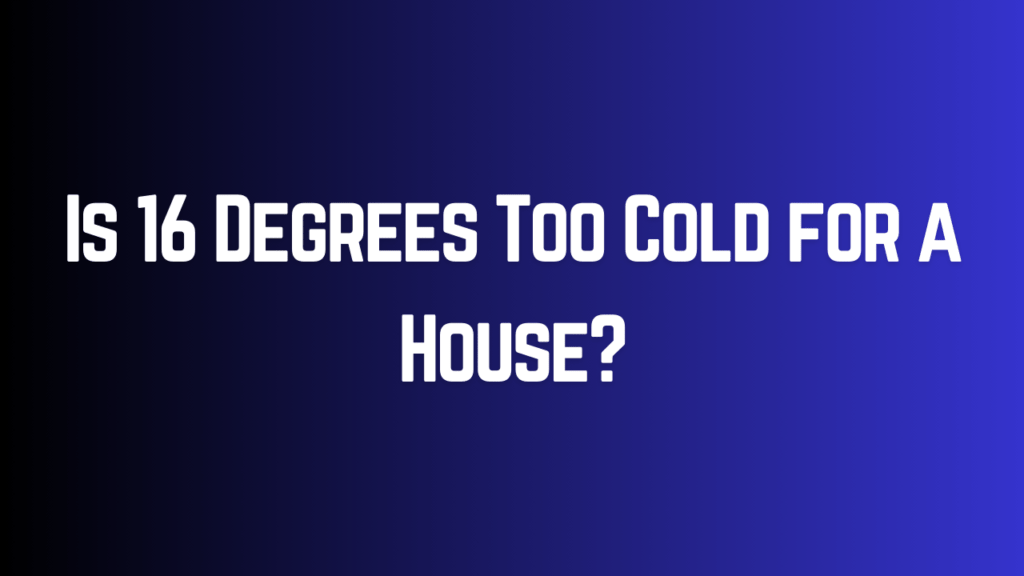
When it comes to the comfort and well-being of your home, temperature plays a crucial role. We all want to live in a cozy, warm environment, especially during the chilly winter months. But have you ever wondered if 16 degrees is too cold for a house? In this comprehensive guide, we’ll delve into the science of indoor temperature, its impact on your health, and how to strike the perfect balance between warmth and energy efficiency.
Is 16 Degrees Too Cold for a House?
The ideal indoor temperature for a house can vary depending on personal preference, but 16 degrees Celsius (60 degrees Fahrenheit) might be considered too cold for most people’s comfort. This temperature is cooler, and many individuals prefer a warmer environment, especially during the colder months.
To ensure comfort and energy efficiency, it’s advisable to maintain indoor temperatures closer to 20-22 degrees Celsius (68-72 degrees Fahrenheit) during the day and slightly cooler at night.
Understanding Indoor Temperature
Before determining if 16 degrees is too cold for a house, it’s essential to understand what indoor temperature represents. Indoor temperature refers to the level of warmth or coldness inside your home, typically measured in degrees Celsius or Fahrenheit. It’s not just a matter of comfort; it also has significant implications for your health and energy consumption.
The Importance of Thermal Comfort
Thermal comfort, defined as the state of mind that expresses satisfaction with the surrounding environment, varies from person to person. What feels warm and cozy to one individual might be too cold for another. Age, gender, clothing, and activity level influence our perception of comfort. However, there are general guidelines for maintaining a comfortable indoor temperature.
Recommended Indoor Temperatures
To answer the question, “Is 16 degrees too cold for a house?” we need to consider established recommendations. According to experts, the ideal indoor temperature during winter is around 18 to 21 degrees Celsius (65 to 70 degrees Fahrenheit) for occupied spaces. This range provides a comfortable environment for most people.
However, it’s worth noting that some individuals, especially the elderly, infants, or those with certain medical conditions, may require slightly higher temperatures to stay comfortable and healthy. For them, 16 degrees might indeed be too cold.
Health Implications of Cold Indoor Temperatures
Maintaining a warm indoor environment isn’t just about comfort; it’s also about your health. Prolonged exposure to low temperatures inside your home can lead to a range of health issues, including:
1. Hypothermia
Hypothermia occurs when your body loses heat faster than it can produce heat, causing a dangerously low body temperature. Temperatures as high as 16 degrees can contribute to this condition, especially if you’re not dressed appropriately.
2. Respiratory Problems
Cold indoor temperatures can exacerbate respiratory problems like asthma. The dry, cold air can irritate your airways and worsen symptoms.
3. Increased Risk of Infections
Cold environments may increase your susceptibility to infections, as your immune system may not function optimally in colder conditions.
4. Poor Sleep Quality
Sleeping in a cold room can lead to disrupted sleep patterns and lower sleep quality. Your body temperature naturally drops when you sleep; excessively cold rooms can interfere with this process.
Balancing Comfort and Energy Efficiency
While maintaining a warm indoor temperature is essential for your health and comfort, it’s also vital to consider energy efficiency and sustainability. Here are some tips to strike the right balance:
1. Insulate Your Home
Proper insulation helps keep your home warm without excessive reliance on heating systems. It can significantly reduce energy consumption and utility bills.
2. Use Programmable Thermostats
Invest in programmable thermostats that allow you to set different temperatures for different times of the day. This ensures you’re warm when needed and can conserve energy when you’re away or asleep.
3. Seal Drafts
Drafts around doors and windows let cold air in and warm air out. Sealing these gaps can make a significant difference in maintaining a comfortable temperature.
4. Dress Warmly
Wearing warm clothing indoors can help you feel comfortable at lower temperatures. Layer up and use blankets to stay cozy.
Conclusion
So, is 16 degrees too cold for a house? The answer depends on various factors, including individual preferences, health considerations, and energy efficiency goals. While 16 degrees may suit some, it could be uncomfortable for others. Striking the right balance between comfort and sustainability is key to ensuring a warm and cozy home during the colder months. Remember to prioritize your health and well-being while being mindful of energy conservation.
